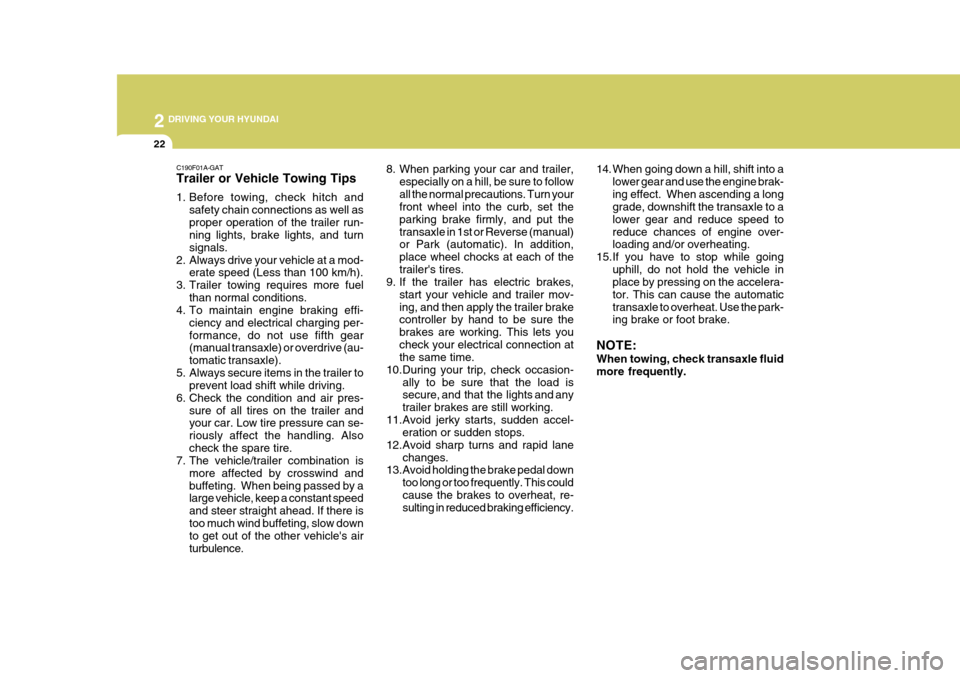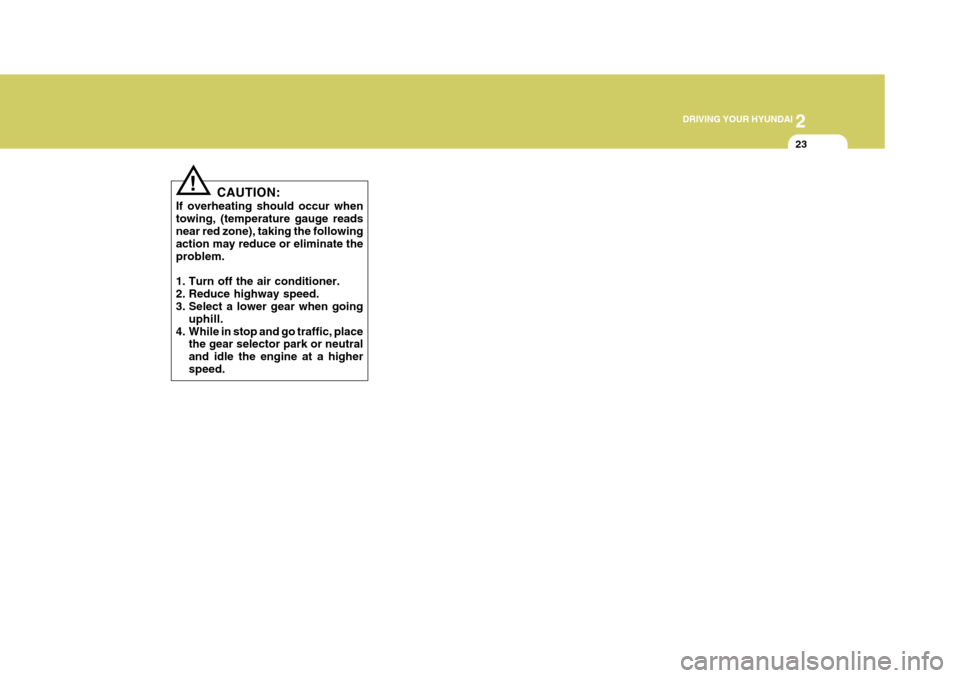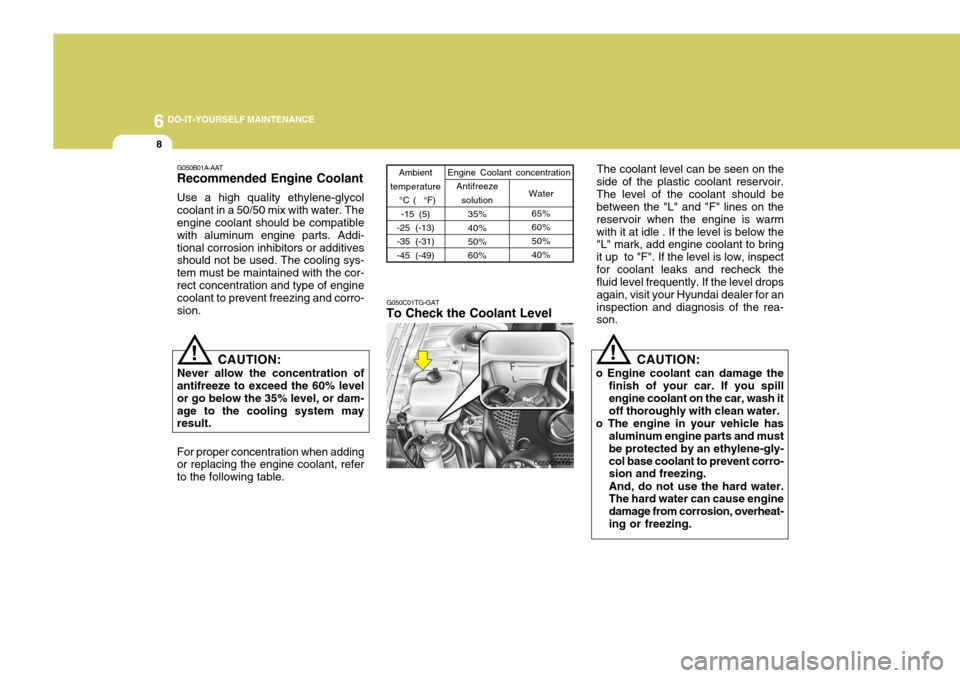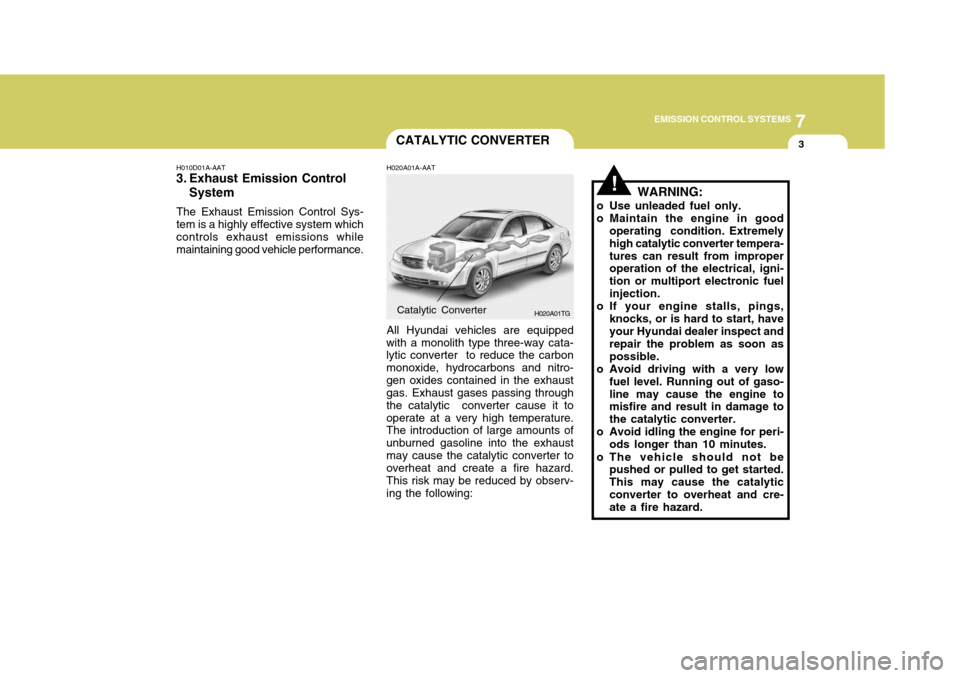2005 Hyundai Azera engine overheat
[x] Cancel search: engine overheatPage 206 of 297

2 DRIVING YOUR HYUNDAI
22
C190F01A-GAT Trailer or Vehicle Towing Tips
1. Before towing, check hitch andsafety chain connections as well as proper operation of the trailer run- ning lights, brake lights, and turn signals.
2. Always drive your vehicle at a mod- erate speed (Less than 100 km/h).
3. Trailer towing requires more fuel than normal conditions.
4. To maintain engine braking effi-
ciency and electrical charging per-formance, do not use fifth gear (manual transaxle) or overdrive (au- tomatic transaxle).
5. Always secure items in the trailer to prevent load shift while driving.
6. Check the condition and air pres- sure of all tires on the trailer and your car. Low tire pressure can se- riously affect the handling. Alsocheck the spare tire.
7. The vehicle/trailer combination is
more affected by crosswind andbuffeting. When being passed by a large vehicle, keep a constant speed and steer straight ahead. If there istoo much wind buffeting, slow down to get out of the other vehicle's air turbulence. 8. When parking your car and trailer,
especially on a hill, be sure to followall the normal precautions. Turn your front wheel into the curb, set the parking brake firmly, and put thetransaxle in 1st or Reverse (manual) or Park (automatic). In addition, place wheel chocks at each of thetrailer's tires.
9. If the trailer has electric brakes,
start your vehicle and trailer mov-ing, and then apply the trailer brake controller by hand to be sure the brakes are working. This lets youcheck your electrical connection at the same time.
10.During your trip, check occasion- ally to be sure that the load issecure, and that the lights and any trailer brakes are still working.
11.Avoid jerky starts, sudden accel- eration or sudden stops.
12.Avoid sharp turns and rapid lane changes.
13.Avoid holding the brake pedal down
too long or too frequently. This couldcause the brakes to overheat, re- sulting in reduced braking efficiency. 14. When going down a hill, shift into a
lower gear and use the engine brak- ing effect. When ascending a long grade, downshift the transaxle to a lower gear and reduce speed toreduce chances of engine over- loading and/or overheating.
15.If you have to stop while going uphill, do not hold the vehicle inplace by pressing on the accelera- tor. This can cause the automatictransaxle to overheat. Use the park- ing brake or foot brake.
NOTE: When towing, check transaxle fluid more frequently.
Page 207 of 297

2
DRIVING YOUR HYUNDAI
23
CAUTION:
If overheating should occur when towing, (temperature gauge reads near red zone), taking the following action may reduce or eliminate theproblem.
1. Turn off the air conditioner.
2. Reduce highway speed.
3. Select a lower gear when going uphill.
4. While in stop and go traffic, place the gear selector park or neutral and idle the engine at a higherspeed.
!
Page 208 of 297

3
If the Engine Will not Start ............................................ 3-2
Jump Starting ............................................................... 3-3
If the Engine Overheats ............................................... 3-4
Spare Tire .................................................................... 3-5
If You Have a Flat Tire ................................................. 3-6
Changing a Flat Tire .................................................... 3-6
If Your Vehicle Must Be Towed ..................................3-10
Emergency Towing ..................................................... 3-12
If You Lose Your K eys ................................................ 3-13
WHAT TO DO IN AN EMERGENCY
3
Page 211 of 297

3 WHAT TO DO IN AN EMERGENCY
4
!
!
IF THE ENGINE OVERHEATS
(If the air conditioning had been in use, it is normal for cold water to bedraining from it when you stop).
D030A01TG-AAT If your temperature gauge indicates overheating, you experience a loss of power, or hear loud pinging or knock- ing, the engine is probably too hot. Ifthis happens to you, you should:
1. Pull off the road and stop as soon as
it is safe to do so.
2. Place the gear selector lever in "P"
and set the parking brake. If the air conditioning is on, turn it off.
3. If engine coolant is running out under
the car or steam is coming out fromthe hood, stop the engine. Do not open the hood until the engine coolant has stopped running or thesteaming has stopped. If there is no visible loss of coolant and no steam, leave the engine running and checkto be sure the engine cooling fan is operating. If the fan is not running, turn the engine off.
4. Check to see if the water pump drive belt is missing. If it is not missing,check to see that it is tight. If thedrive belt seems to be satisfactory, check for engine coolant leaking from the radiator, hoses or under the car.
6. Carefully remove the jumper cables
in the reverse order of attachment.
If you do not know why your batterybecame discharged (because the lightswere left on, etc.), have the charging system checked by your Hyundai dealer. WARNING:
While the engine is running, keephands and clothing away from mov-ing parts such as the fan and drive belts to prevent injury.
5. If the water pump drive belt is broken or coolant is leaking out, stop theengine immediately and call the near- est Hyundai dealer for assistance.
WARNING:
Do not remove the radiator cap whenthe engine is hot. This can allow coolant to be blown out of the open- ing and cause serious burns.
Page 212 of 297

3
WHAT TO DO IN AN EMERGENCY
5
6. If you cannot find the cause of the
overheating, wait until the engine temperature has returned to nor- mal. Then, if coolant has been lost, carefully add coolant to the reservoir(Page 6-8) to bring the fluid level in the reservoir up to the halfway mark.
7. Proceed with caution, keeping alert for further signs of overheating. Ifoverheating happens again, call a Hyundai dealer for assistance.
! CAUTION:
Serious loss of coolant indicates there is a leak in the cooling system and this should be checked as soonas possible by a Hyundai dealer.
SPARE TIRE
D040B01TG-GAT Handling the Spare Tire
1. Open the trunk lid.
2. Remove the luggage mat.
3. Take out the tool receptacle.
Spare Tire Pressure
D040A01TG-GAT The following instructions for the FULL SIZE spare tire should be observed: Check inflation pressure as soon as practical after installing the spare tire, and adjust to the specified pressure. The tire pressure should be periodi-cally checked and maintained at the specified pressure while the tire is stored.
Tire Size Inflation PressureFull Size 210 kPa (30 psi)
HNF4008
4. Turn the installation bolt counter- clockwise to remove the spare tire.
5. After replacing the spare tire, install and tighten the bolt firmly with your fingers until there is no more play inthe spare tire.
Page 244 of 297

6 DO-IT-YOURSELF MAINTENANCE
8
!
The coolant level can be seen on the
side of the plastic coolant reservoir. The level of the coolant should be between the "L" and "F" lines on the reservoir when the engine is warmwith it at idle . If the level is below the "L" mark, add engine coolant to bring it up to "F". If the level is low, inspectfor coolant leaks and recheck the fluid level frequently. If the level drops again, visit your Hyundai dealer for aninspection and diagnosis of the rea- son.
G050C01TG-GAT
To Check the Coolant Level
G050C01TG
Ambient
temperature °C ( °F)
-15 (5)
-25 (-13) -35 (-31)-45 (-49)
65% 60%50%40%
35%40% 50% 60% Water
Antifreeze
solution
Engine Coolant concentration
CAUTION:
o Engine coolant can damage the finish of your car. If you spill engine coolant on the car, wash it off thoroughly with clean water.
o The engine in your vehicle has aluminum engine parts and mustbe protected by an ethylene-gly-col base coolant to prevent corro- sion and freezing. And, do not use the hard water. The hard water can cause engine damage from corrosion, overheat-ing or freezing.
!
G050B01A-AAT
Recommended Engine Coolant
Use a high quality ethylene-glycol coolant in a 50/50 mix with water. The engine coolant should be compatible with aluminum engine parts. Addi-tional corrosion inhibitors or additives should not be used. The cooling sys- tem must be maintained with the cor-rect concentration and type of engine coolant to prevent freezing and corro- sion.
CAUTION:
Never allow the concentration of antifreeze to exceed the 60% level or go below the 35% level, or dam-age to the cooling system may result. For proper concentration when adding or replacing the engine coolant, refer to the following table.
Page 280 of 297

7
EMISSION CONTROL SYSTEMS
3
!
CATALYTIC CONVERTER
H020A01A-AAT All Hyundai vehicles are equipped
with a monolith type three-way cata- lytic converter to reduce the carbon monoxide, hydrocarbons and nitro-gen oxides contained in the exhaust gas. Exhaust gases passing through the catalytic converter cause it tooperate at a very high temperature. The introduction of large amounts of unburned gasoline into the exhaustmay cause the catalytic converter to overheat and create a fire hazard. This risk may be reduced by observ-ing the following: Catalytic Converter
H010D01A-AAT
3. Exhaust Emission Control
System
The Exhaust Emission Control Sys-tem is a highly effective system which controls exhaust emissions while maintaining good vehicle performance. WARNING:
o Use unleaded fuel only.
o Maintain the engine in good operating condition. Extremely high catalytic converter tempera-tures can result from improper operation of the electrical, igni- tion or multiport electronic fuelinjection.
o If your engine stalls, pings, knocks, or is hard to start, have your Hyundai dealer inspect and repair the problem as soon aspossible.
o Avoid driving with a very low fuel level. Running out of gaso-line may cause the engine to misfire and result in damage to the catalytic converter.
o Avoid idling the engine for peri-
ods longer than 10 minutes.
o The vehicle should not be pushed or pulled to get started.This may cause the catalyticconverter to overheat and cre- ate a fire hazard.
H020A01TG
Page 294 of 297

10
INDEX
3
Console Box .............................................................. 1-96
Cooling Fans ............................................................. 6-25
Corrosion protection
Cleaning the interior .................................................. 4-5
Protecting your Hyundai from corrosion ................... 4-2
Washing and waxing ................................................. 4-4
Cruise Control .......................................................... 1-109
D Defrosting/Defogging ................................................ 1-119
Door
Central door locks .................................................. 1-12
Door edge warning light ........ ................................1-107
Door locks ................................................................ 1-9
Locking and unlocking front door with a key .......... 1-10
Drink Holder ............................................................... 1-87
Drive Belt ................................................................... 6-21
Driving Driving for economy ............................................... 2-14
Smooth corneri ng .................................................... 2-16
Winter driving .......................................................... 2-16
E Electronic Stability Program (ESP) ...........................2-11
Emission Contro l System ............................................ 7-2
Engine Before starting the engine ........................................ 2-3Compartment ............................................................ 6-2
Coolant ..................................................................... 6-7 Coolant temperature gauge
.....................................1-71
If the engine overheats ............................................. 3-4
Number ..................................................................... 8-2
Oil ............................................................................. 6-4 Starting ..................................................................... 2-5
Engine Exhaust Can Be Dangerous ............................ 2-2
F
Fan Speed Control ............. ...........................1-115, 1-125
Fog Light Switch Front ....................................................................... 1-79
Rear ........................................................................ 1-80
Front Seats
Active headrests ..................................................... 1-23
Adjustable front seats ............................................. 1-21
Adjustable headrests .............................................. 1-22
Adjusting seat forward and rearward .......................1-21
Adjusting seatback angle ....................................... 1-21
Power seat ............................................................. 1-24
Fuel Capacity ................................................................... 9-2
Gauge ..................................................................... 1-70
Recommendations .................................................... 1-2
Fuel Filler Lid Remote release .................................................... 1-103
Fuse Panel Description ............................................. 6-37
Fuses ........................................................................ 6-21